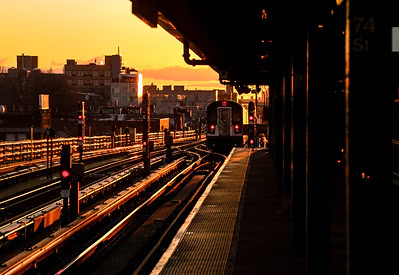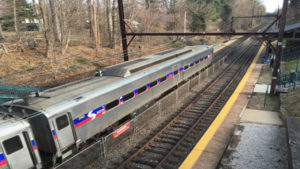WMATA Proposes ‘Severe Cuts’ in FY2025 Budget (UPDATED, 12/20) –– From Our Colleagues at Railway Age
Written by Carolina Worrell, Senior Editor, Railway Age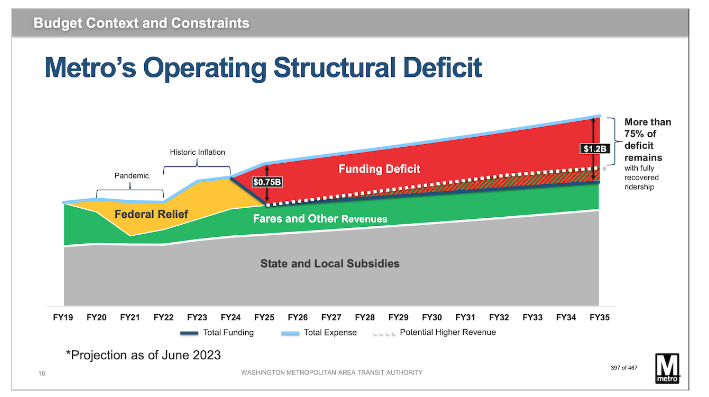
WASHINGTON, D.C. –– The Washington Metropolitan Area Transit Authority (WMATA) has released its proposed operating and capital budget for fiscal year 2025 (FY2025), which calls for “severe cuts” to address the agency’s $750 structural funding shortfall—a deficit equal to more than 25% of the operating budget—despite “proactive management actions” taken by WMATA to control expenses.
The FY2025 Proposed Budget, according to WMATA, includes “unprecedented” service cuts to Metrorail and Metrobus and an increase of fares across all modes. Metrorail service cuts will include longer headways across the system; Red Line “turnbacks” at Grosvenor-Strathmore and Silver Spring Stations, reducing train frequencies for end-of-line stations; Silver Line “turnbacks” at Stadium-Armory and Silver Line service between Ashburn and Stadium-Armory only, reducing train frequencies to Downtown Largo; closure of 10 stations; a 10 p.m. closing time across the system; and decreased service on all lines, reducing the number of trips with six minutes or better service from 81% in FY2024 to 10% in FY2025. MetroAccess service will be reduced to reflect the legally required service area and hours based on the decreased Metrorail and Metrobus service levels. Additionally, the FY2025 Proposed Budget includes a 20% general increase in fares and parking fees.
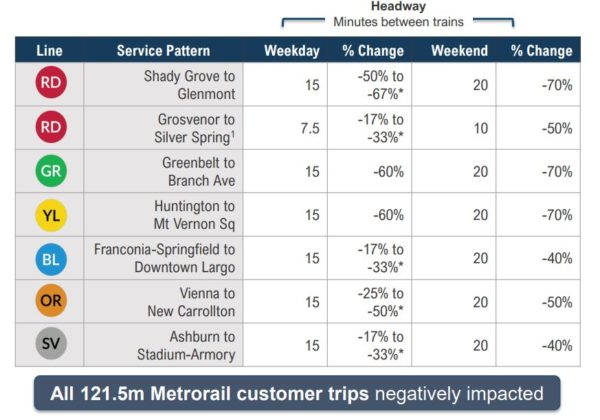
According to the proposed budget (download below), “fundamental changes in post-pandemic travel patterns and unprecedented inflationary pressures have imposed fiscal constraints significantly impacting future operations and investments.”
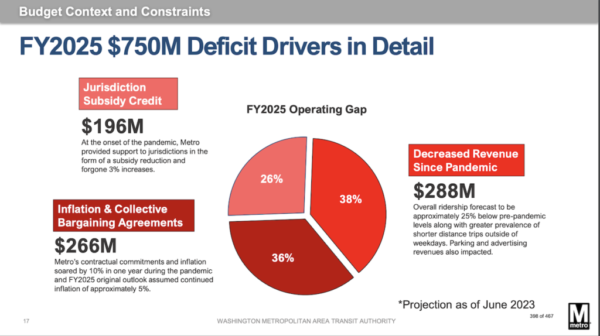
Higher deficits are forecast in the out-years even if ridership fully recovers to pre-pandemic levels, according to WMATA. Despite the agency’s focus on service improvements, mobility and equity, without additional funding the FY2025 Proposed Budget “significantly reduces service and raises fares to submit a balanced budget as required under the WMATA Compact.”
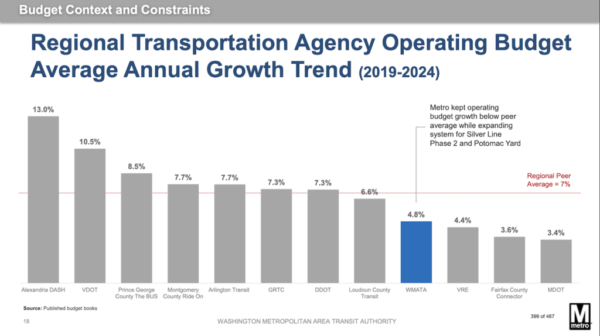
According to WMATA, ridership continues to grow; however, the FY2024 budget predicted “a more aggressive return of long-distance weekday trips than has occurred to date.” Based on forecasted ridership results for first-quarter FY2024 (which began Oct. 1, 2023) the agency updated revenue forecasts based on the mix of trips seen to date during the quarter. Due to changes in ridership patterns with shorter-distance trips and a higher percentage of flat fare trips, the proposed budget assumes baseline revenue of $67 million less for FY2025 than June 2023 estimates.
Without a sustainable and predictable funding source to replace federal relief funding, the FY2025 Proposed Budget, the agency says, presents “an unrecognizable Metro due to unprecedented service cuts necessary to close the operating deficit.”
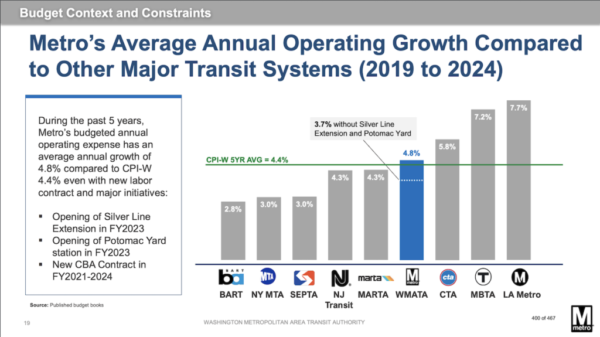
“A financial strategy that indexes our operating and capital funding to inflation would provide Metro with predictability and long-term sustainability so the region can meet its economic and mobility goals,” the agency said. “Of its transit peers nationwide, WMATA alone lacks a dedicated source of operating funding limiting our ability to plan with certainty beyond the current fiscal year.”
WMATA’s “internal levers to combat this structural deficit” include:
- “Internal efficiencies: Robust financial management by identifying operating efficiencies, administrative improvements, and continued oversight to controls costs and increase productivity.
- “Policy decisions: Adjusting fares, service levels and the continued use of preventive maintenance transfers from operating to capital budgets consistent with FTA policies.”
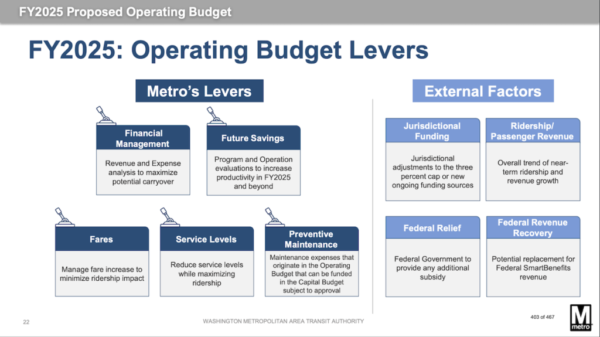
External levers, those outside of the agency’s control, include an increase in jurisdictional subsidies or new funding sources, additional federal relief funding, ridership patterns that increase revenues, and federal transit benefit revenue recovery. Given current legal funding constraints and other measures outside of WMATA’s control, the FY2025 Proposed Budget “uses all internal levers to close the operating deficit.”
The major service cuts and additional administrative reductions, WMATA says, will result in a $500 million decrease in operating expenses while the revenue loss from the major service cuts, including non-passenger revenue, totals $95 million. The fare and parking increase would generate $29 million more in revenue for a net savings of $433 million and close the FY2025 deficit, according to the agency.
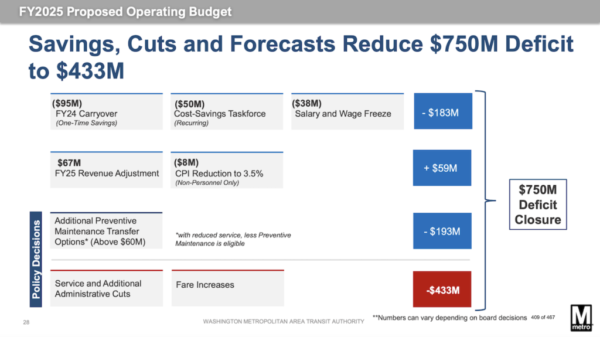
“Closing this deficit through major service cuts and fare increases will make Metro unrecognizable, halting the ridership recovery, reducing or eliminating service across all modes, and necessitate steep reductions in maintenance, police presence, and customer service functions,” the agency said. “Customers will experience severe crowding, longer police response times, and more frequent elevator and escalator outages. These service cuts are below current capacity needs and will likely trigger a death spiral of a loss of ridership, detrimentally impacting the region into the future through worse traffic, reduced access to jobs and opportunities, and more pollution. In addition, these budget cuts will eliminate over 2,200 Metro positions.”
The FY2025 Proposed Operating Budget (excluding reimbursables and debt service) of $1.8 billion is 23% lower than the FY2024 operating budget based on “severe” service cuts. At $310.7 million, passenger revenue is projected to be 23% lower than FY2024, and non-passenger revenue is projected to decrease by 12.2%. This budget includes the remaining $95 million in federal relief funding available in FY2025 and adheres to the 3% cap for the jurisdictional subsidy.
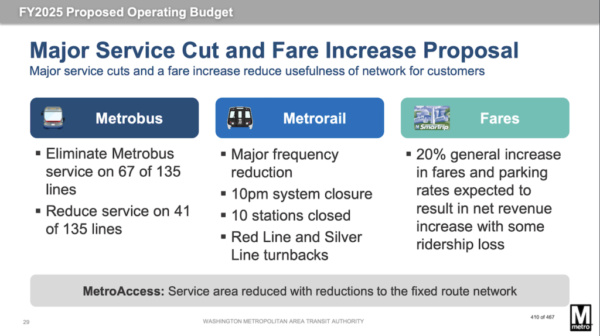
Additionally, WMATA is currently projecting $11 billion in capital funding for FY2025-FY2030, which the agency says is “less than $17 billion in total identified program needs for that time period.”
While the proposed $11 billion program addresses critical overdue needs, WMATA says it results in a “declining capacity for state-of-good-repair (SOGR) and modernization investments, especially when dedicated funding debt capacity is exhausted.” As the available capital funding decreases, the agency says it “becomes unable to address more and more SOGR needs, increasing the backlog and jeopardizing the safety and reliability of the system through recurring asset failures.”
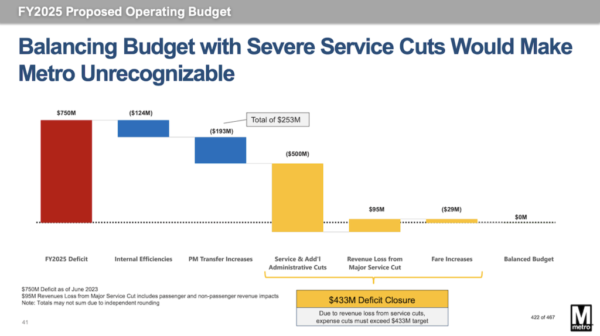
“Increased use of preventive maintenance transfers reduces capacity for other capital investments in the long-term, putting at risk priority investments such as the full-scale Heavy Repair and Overhaul Facility, the 8000-Series [railcar] Fleet of the Future, Zero-Emission Buses and Garages, Next-Gen Automation and Signaling, and the Blue/Orange/Silver Corridor. Further, Metro’s use of additional preventive maintenance transfers reduces critical capital investments and accelerates the beginning of Metro’s capital deficit from FY2029 to FY2028,” the agency said.
WMATA’s FY2025-FY2030 Capital Improvement Program (CIP) was initially developed to “continue the trend toward reducing the state of good repair backlog, while also providing budget authority for transformational investments,” according to the agency. Given the current funding outlook and inflationary pressures, WMATA’s available funding is functionally reduced leading to:
- Longer time between rehabilitation and replacement cycles.
- Reduced ability to address backlogged needs.
- Reduced ability to advance transformational projects and regional initiatives.
The proposed budget (download below) provides an overview of the capital program that WMATA says can be delivered with $11 billion of anticipated funding over six years. This program, WMATA adds, will address ongoing contract commitments and essential SOGR needs but will not address other SOGR, modernization or expansion projects. In the context of this proposed budget, essential SOGR projects excludes some basic SOGR projects, potentially halting progress on the efforts to reduce the SOGR backlog, or worse, beginning to increase it.
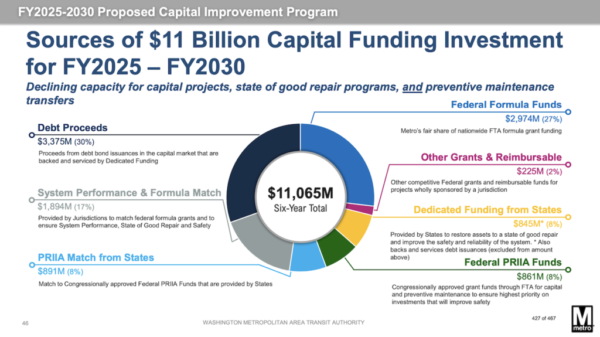
According to WMATA, the proposed FY25 capital budget is $2.6 billion, including debt service and revenue loss from capital projects.
In summary, the agency’s $4.5 billion FY2025 Proposed Budget “will maintain the legislatively mandated 3% cap to the operating subsidy through severe service cuts and fare increases. As evident in recent years, changes to inflation, labor market conditions, global instability, supply chain constraints,and ridership patterns continue to pose external risks to the agency.”
WMATA staff will return in January to seek approval for the Public Authorization Hearings. Following approval by the Board, stakeholder and community engagement actions will follow.
“Metro is facing an unprecedented, existential crisis that requires our region to rally together if we want to avoid the catastrophic impacts this budget would have on our region,” said Metro General Manager and CEO Randy Clarke. “I’m so proud of Metro and our dedicated workforce that has helped deliver over a dozen recent service improvements and are providing great service for our region all day, seven days a week. We are doing everything in our power to avoid the doomsday scenario outlined in this budget proposal, but we must also be transparent and honest about how devastating these cuts would be if additional funding isn’t secured.”
Click on the following link to read or download the FY2025 Budget.
12/20/23 Update
On Dec. 19, the Metropolitan Washington Council of Governments (COG) announced that it has put together a working group to develop strategies to address WMATA’s $750 million deficits without making the “drastic” level of service cuts and layoffs suggested in the agency’s proposed budget, according to a report by WTOP News.
“Metro is running great service right now and they’re tightening their belt, and they need to continue to do that,” COG Executive Director Clark Mercer told WTOP.
According to the report, the work group, which is comprised of leaders from D.C., Maryland and Virginia, released a report Tuesday that includes near-term recommendations to WMATA, such as “transferring some capital funding to cover operating costs, increasing fares and implementing targeted service reductions.”
“Part of addressing the deficit will mean those entities that typically help pay Metro’s bill will have to give the transit agency more funds than in recent years,” Mercer said.
According to the report, federal relied during the pandemic meant that local governments owed less money to WMATA. But more recent bills are “artificially low,” Mercer said, adding that those bills “need to catch up to inflation and cost increases,” which would make up for more than half of the $750 million deficit.
“That would be spread amongst the members that pay Metro’s bills in Maryland, Virginia and D.C.,” he said. “I think they’re prepared to pay that bill … but they want to make sure that Metro is doing everything it can to provide really great service at the most reasonable price.”
WMATA’s proposed budget would make significant cuts to service, including potentially closing 10 of the least-traveled stations but Mercer said, “it’s unclear to leaders in COG what stations or lines this would impact.”
According to the WTOP News report, the work group is advising against those “drastic” cuts and opting for targeted service reductions instead of significant cuts or closures.
“There’s something probably a bit more nuanced that we can arrive at, which is trimming some of the service that will save some money, but not result in what they call a ‘transit death spiral,’” Mercer said.
Riders, Mercer says, “should also expect to be paying more as costs have increased while fares have remained ‘fairly steady.’”
At the same time, the report says, “the transit agency should continue its efforts to crack down on fare evasion, the report said, while ensuring access to programs that help people in need to ride Metro.”
As far as whether the extreme cuts outlined by WMATA in its proposed budget last week will come to fruition, Mercer said “he doesn’t think the region will accept those changes.” He also noted that the agency’s proposed budget “reflects if we don’t step up and pay our Metro bills.”
Mercer, WTOP News reports, emphasized the importance of maintaining a strong Metro system in the D.C. region from an economic development standpoint.
“You don’t have a new arena, you don’t have an FBI that’s relocated anywhere in this region without it being anchored by Metro,” he said.
The full report from the Metropolitan Washington Council of Governments is available below.

